Sociological Analysis: Deviance and Conformity in Media
VerifiedAdded on 2023/05/30
|9
|2176
|166
Essay
AI Summary
This essay critically analyzes the portrayal of deviance and conformity in media, specifically focusing on the issue of Iranian women facing detention for posting images on Instagram deemed 'inappropriate.' The paper examines how digital media, like the Independent newspaper, highlights the breaking of social norms and values, particularly concerning the hijab. It delves into sociological determinants, exploring the impact of stringent social norms and male dominance. The essay discusses the concept of hijab, veiling, and its interpretations within religious and cultural contexts, including feminist perspectives and social control theory. It examines the application of labels to women who do not conform to conventional Islamic morals, addressing the pressures faced by women who challenge traditional norms. The analysis considers the various representations of Muslim women in Western media and the complexities of veiling practices, concluding with a call for a deeper examination of patriarchy and prejudice affecting Muslim women's lives.
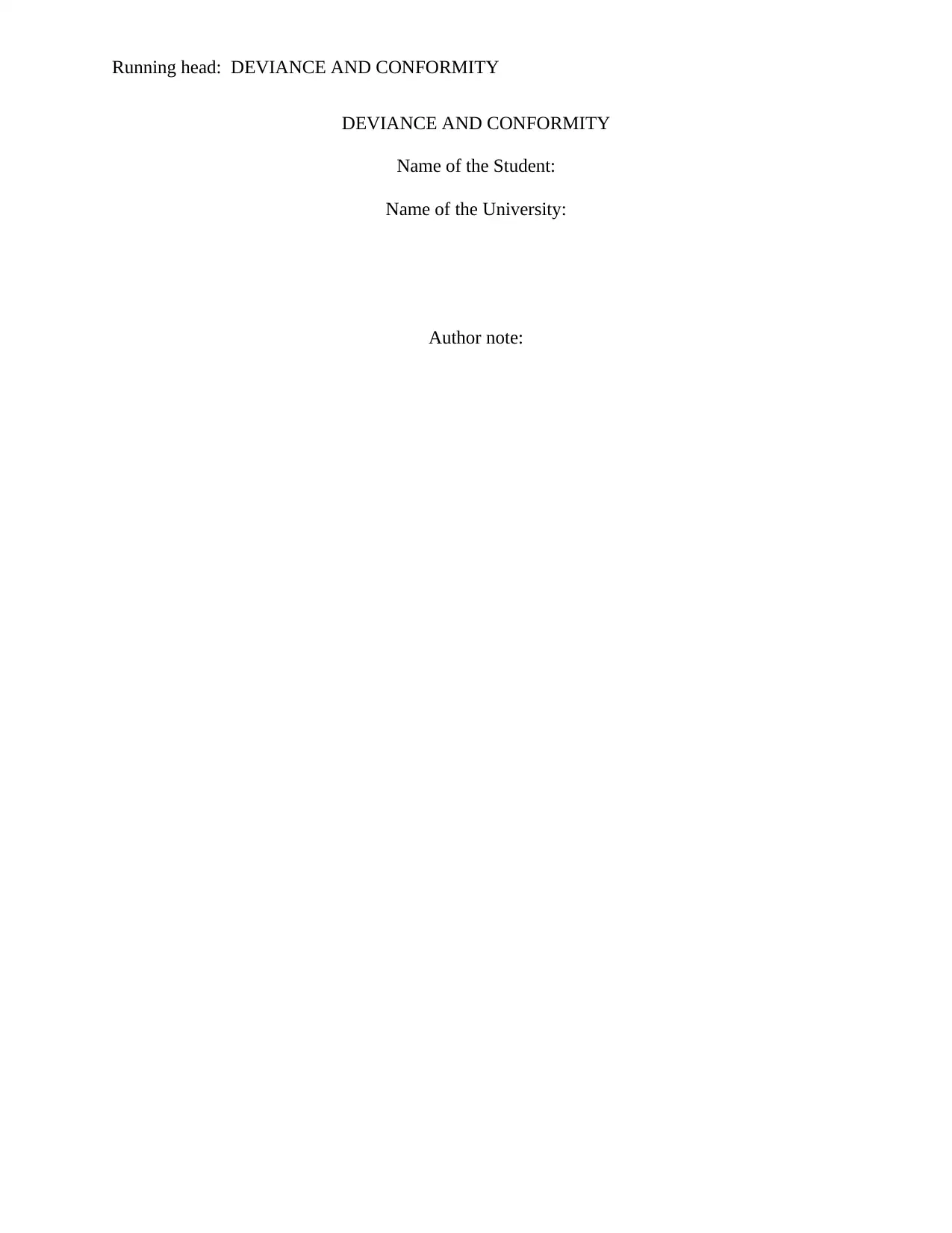
Running head: DEVIANCE AND CONFORMITY
DEVIANCE AND CONFORMITY
Name of the Student:
Name of the University:
Author note:
DEVIANCE AND CONFORMITY
Name of the Student:
Name of the University:
Author note:
Paraphrase This Document
Need a fresh take? Get an instant paraphrase of this document with our AI Paraphraser
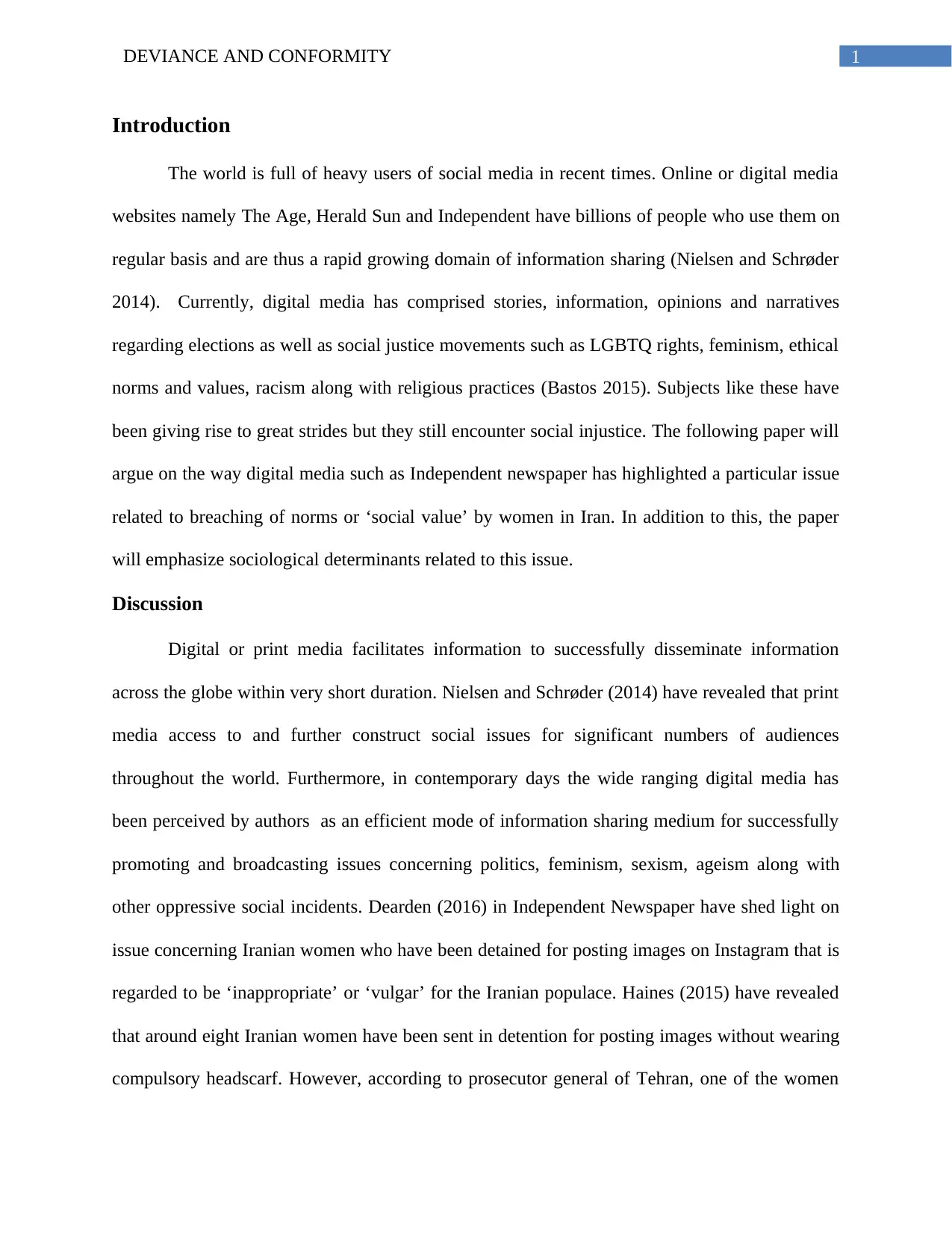
1DEVIANCE AND CONFORMITY
Introduction
The world is full of heavy users of social media in recent times. Online or digital media
websites namely The Age, Herald Sun and Independent have billions of people who use them on
regular basis and are thus a rapid growing domain of information sharing (Nielsen and Schrøder
2014). Currently, digital media has comprised stories, information, opinions and narratives
regarding elections as well as social justice movements such as LGBTQ rights, feminism, ethical
norms and values, racism along with religious practices (Bastos 2015). Subjects like these have
been giving rise to great strides but they still encounter social injustice. The following paper will
argue on the way digital media such as Independent newspaper has highlighted a particular issue
related to breaching of norms or ‘social value’ by women in Iran. In addition to this, the paper
will emphasize sociological determinants related to this issue.
Discussion
Digital or print media facilitates information to successfully disseminate information
across the globe within very short duration. Nielsen and Schrøder (2014) have revealed that print
media access to and further construct social issues for significant numbers of audiences
throughout the world. Furthermore, in contemporary days the wide ranging digital media has
been perceived by authors as an efficient mode of information sharing medium for successfully
promoting and broadcasting issues concerning politics, feminism, sexism, ageism along with
other oppressive social incidents. Dearden (2016) in Independent Newspaper have shed light on
issue concerning Iranian women who have been detained for posting images on Instagram that is
regarded to be ‘inappropriate’ or ‘vulgar’ for the Iranian populace. Haines (2015) have revealed
that around eight Iranian women have been sent in detention for posting images without wearing
compulsory headscarf. However, according to prosecutor general of Tehran, one of the women
Introduction
The world is full of heavy users of social media in recent times. Online or digital media
websites namely The Age, Herald Sun and Independent have billions of people who use them on
regular basis and are thus a rapid growing domain of information sharing (Nielsen and Schrøder
2014). Currently, digital media has comprised stories, information, opinions and narratives
regarding elections as well as social justice movements such as LGBTQ rights, feminism, ethical
norms and values, racism along with religious practices (Bastos 2015). Subjects like these have
been giving rise to great strides but they still encounter social injustice. The following paper will
argue on the way digital media such as Independent newspaper has highlighted a particular issue
related to breaching of norms or ‘social value’ by women in Iran. In addition to this, the paper
will emphasize sociological determinants related to this issue.
Discussion
Digital or print media facilitates information to successfully disseminate information
across the globe within very short duration. Nielsen and Schrøder (2014) have revealed that print
media access to and further construct social issues for significant numbers of audiences
throughout the world. Furthermore, in contemporary days the wide ranging digital media has
been perceived by authors as an efficient mode of information sharing medium for successfully
promoting and broadcasting issues concerning politics, feminism, sexism, ageism along with
other oppressive social incidents. Dearden (2016) in Independent Newspaper have shed light on
issue concerning Iranian women who have been detained for posting images on Instagram that is
regarded to be ‘inappropriate’ or ‘vulgar’ for the Iranian populace. Haines (2015) have revealed
that around eight Iranian women have been sent in detention for posting images without wearing
compulsory headscarf. However, according to prosecutor general of Tehran, one of the women
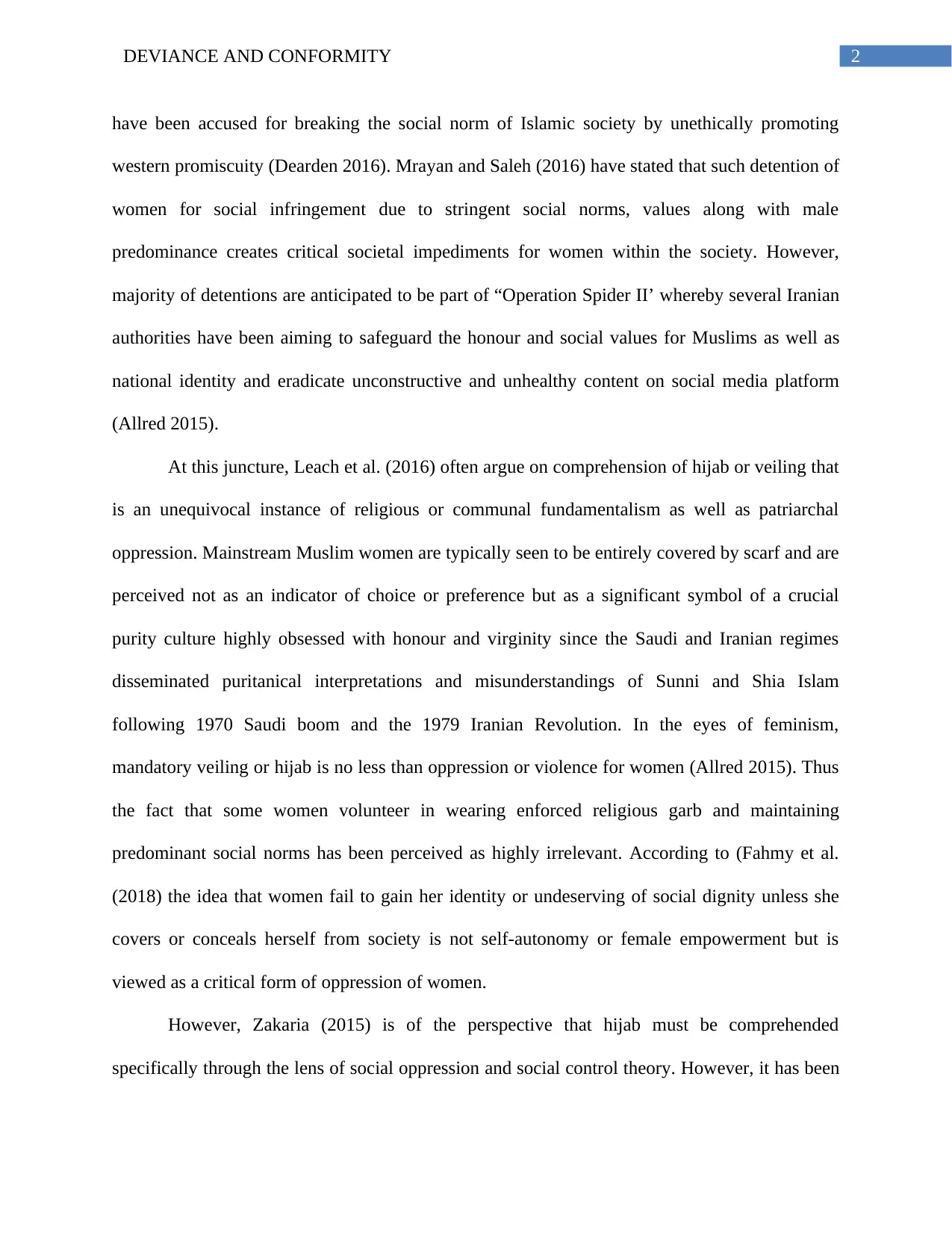
2DEVIANCE AND CONFORMITY
have been accused for breaking the social norm of Islamic society by unethically promoting
western promiscuity (Dearden 2016). Mrayan and Saleh (2016) have stated that such detention of
women for social infringement due to stringent social norms, values along with male
predominance creates critical societal impediments for women within the society. However,
majority of detentions are anticipated to be part of “Operation Spider II’ whereby several Iranian
authorities have been aiming to safeguard the honour and social values for Muslims as well as
national identity and eradicate unconstructive and unhealthy content on social media platform
(Allred 2015).
At this juncture, Leach et al. (2016) often argue on comprehension of hijab or veiling that
is an unequivocal instance of religious or communal fundamentalism as well as patriarchal
oppression. Mainstream Muslim women are typically seen to be entirely covered by scarf and are
perceived not as an indicator of choice or preference but as a significant symbol of a crucial
purity culture highly obsessed with honour and virginity since the Saudi and Iranian regimes
disseminated puritanical interpretations and misunderstandings of Sunni and Shia Islam
following 1970 Saudi boom and the 1979 Iranian Revolution. In the eyes of feminism,
mandatory veiling or hijab is no less than oppression or violence for women (Allred 2015). Thus
the fact that some women volunteer in wearing enforced religious garb and maintaining
predominant social norms has been perceived as highly irrelevant. According to (Fahmy et al.
(2018) the idea that women fail to gain her identity or undeserving of social dignity unless she
covers or conceals herself from society is not self-autonomy or female empowerment but is
viewed as a critical form of oppression of women.
However, Zakaria (2015) is of the perspective that hijab must be comprehended
specifically through the lens of social oppression and social control theory. However, it has been
have been accused for breaking the social norm of Islamic society by unethically promoting
western promiscuity (Dearden 2016). Mrayan and Saleh (2016) have stated that such detention of
women for social infringement due to stringent social norms, values along with male
predominance creates critical societal impediments for women within the society. However,
majority of detentions are anticipated to be part of “Operation Spider II’ whereby several Iranian
authorities have been aiming to safeguard the honour and social values for Muslims as well as
national identity and eradicate unconstructive and unhealthy content on social media platform
(Allred 2015).
At this juncture, Leach et al. (2016) often argue on comprehension of hijab or veiling that
is an unequivocal instance of religious or communal fundamentalism as well as patriarchal
oppression. Mainstream Muslim women are typically seen to be entirely covered by scarf and are
perceived not as an indicator of choice or preference but as a significant symbol of a crucial
purity culture highly obsessed with honour and virginity since the Saudi and Iranian regimes
disseminated puritanical interpretations and misunderstandings of Sunni and Shia Islam
following 1970 Saudi boom and the 1979 Iranian Revolution. In the eyes of feminism,
mandatory veiling or hijab is no less than oppression or violence for women (Allred 2015). Thus
the fact that some women volunteer in wearing enforced religious garb and maintaining
predominant social norms has been perceived as highly irrelevant. According to (Fahmy et al.
(2018) the idea that women fail to gain her identity or undeserving of social dignity unless she
covers or conceals herself from society is not self-autonomy or female empowerment but is
viewed as a critical form of oppression of women.
However, Zakaria (2015) is of the perspective that hijab must be comprehended
specifically through the lens of social oppression and social control theory. However, it has been
⊘ This is a preview!⊘
Do you want full access?
Subscribe today to unlock all pages.

Trusted by 1+ million students worldwide
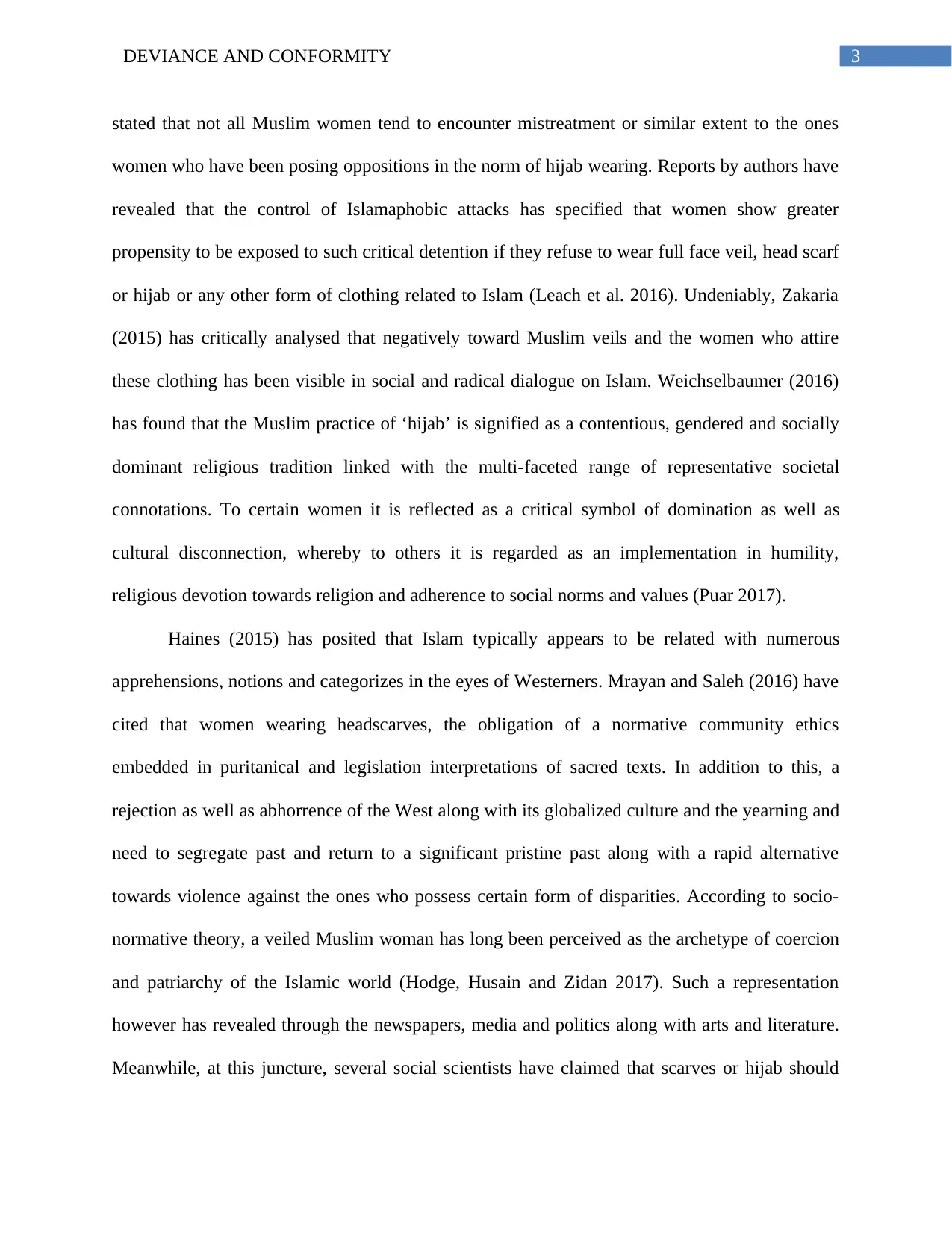
3DEVIANCE AND CONFORMITY
stated that not all Muslim women tend to encounter mistreatment or similar extent to the ones
women who have been posing oppositions in the norm of hijab wearing. Reports by authors have
revealed that the control of Islamaphobic attacks has specified that women show greater
propensity to be exposed to such critical detention if they refuse to wear full face veil, head scarf
or hijab or any other form of clothing related to Islam (Leach et al. 2016). Undeniably, Zakaria
(2015) has critically analysed that negatively toward Muslim veils and the women who attire
these clothing has been visible in social and radical dialogue on Islam. Weichselbaumer (2016)
has found that the Muslim practice of ‘hijab’ is signified as a contentious, gendered and socially
dominant religious tradition linked with the multi-faceted range of representative societal
connotations. To certain women it is reflected as a critical symbol of domination as well as
cultural disconnection, whereby to others it is regarded as an implementation in humility,
religious devotion towards religion and adherence to social norms and values (Puar 2017).
Haines (2015) has posited that Islam typically appears to be related with numerous
apprehensions, notions and categorizes in the eyes of Westerners. Mrayan and Saleh (2016) have
cited that women wearing headscarves, the obligation of a normative community ethics
embedded in puritanical and legislation interpretations of sacred texts. In addition to this, a
rejection as well as abhorrence of the West along with its globalized culture and the yearning and
need to segregate past and return to a significant pristine past along with a rapid alternative
towards violence against the ones who possess certain form of disparities. According to socio-
normative theory, a veiled Muslim woman has long been perceived as the archetype of coercion
and patriarchy of the Islamic world (Hodge, Husain and Zidan 2017). Such a representation
however has revealed through the newspapers, media and politics along with arts and literature.
Meanwhile, at this juncture, several social scientists have claimed that scarves or hijab should
stated that not all Muslim women tend to encounter mistreatment or similar extent to the ones
women who have been posing oppositions in the norm of hijab wearing. Reports by authors have
revealed that the control of Islamaphobic attacks has specified that women show greater
propensity to be exposed to such critical detention if they refuse to wear full face veil, head scarf
or hijab or any other form of clothing related to Islam (Leach et al. 2016). Undeniably, Zakaria
(2015) has critically analysed that negatively toward Muslim veils and the women who attire
these clothing has been visible in social and radical dialogue on Islam. Weichselbaumer (2016)
has found that the Muslim practice of ‘hijab’ is signified as a contentious, gendered and socially
dominant religious tradition linked with the multi-faceted range of representative societal
connotations. To certain women it is reflected as a critical symbol of domination as well as
cultural disconnection, whereby to others it is regarded as an implementation in humility,
religious devotion towards religion and adherence to social norms and values (Puar 2017).
Haines (2015) has posited that Islam typically appears to be related with numerous
apprehensions, notions and categorizes in the eyes of Westerners. Mrayan and Saleh (2016) have
cited that women wearing headscarves, the obligation of a normative community ethics
embedded in puritanical and legislation interpretations of sacred texts. In addition to this, a
rejection as well as abhorrence of the West along with its globalized culture and the yearning and
need to segregate past and return to a significant pristine past along with a rapid alternative
towards violence against the ones who possess certain form of disparities. According to socio-
normative theory, a veiled Muslim woman has long been perceived as the archetype of coercion
and patriarchy of the Islamic world (Hodge, Husain and Zidan 2017). Such a representation
however has revealed through the newspapers, media and politics along with arts and literature.
Meanwhile, at this juncture, several social scientists have claimed that scarves or hijab should
Paraphrase This Document
Need a fresh take? Get an instant paraphrase of this document with our AI Paraphraser
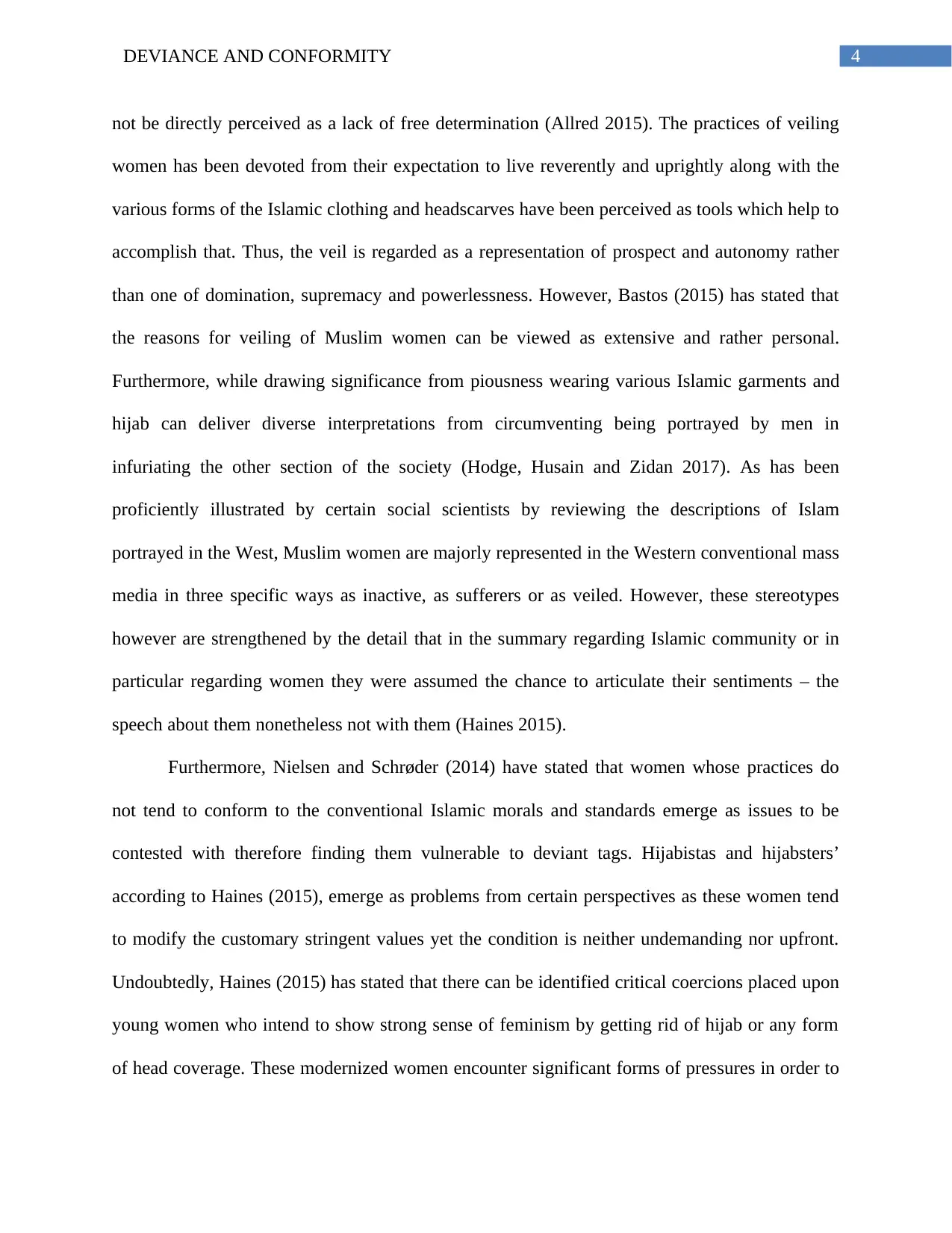
4DEVIANCE AND CONFORMITY
not be directly perceived as a lack of free determination (Allred 2015). The practices of veiling
women has been devoted from their expectation to live reverently and uprightly along with the
various forms of the Islamic clothing and headscarves have been perceived as tools which help to
accomplish that. Thus, the veil is regarded as a representation of prospect and autonomy rather
than one of domination, supremacy and powerlessness. However, Bastos (2015) has stated that
the reasons for veiling of Muslim women can be viewed as extensive and rather personal.
Furthermore, while drawing significance from piousness wearing various Islamic garments and
hijab can deliver diverse interpretations from circumventing being portrayed by men in
infuriating the other section of the society (Hodge, Husain and Zidan 2017). As has been
proficiently illustrated by certain social scientists by reviewing the descriptions of Islam
portrayed in the West, Muslim women are majorly represented in the Western conventional mass
media in three specific ways as inactive, as sufferers or as veiled. However, these stereotypes
however are strengthened by the detail that in the summary regarding Islamic community or in
particular regarding women they were assumed the chance to articulate their sentiments – the
speech about them nonetheless not with them (Haines 2015).
Furthermore, Nielsen and Schrøder (2014) have stated that women whose practices do
not tend to conform to the conventional Islamic morals and standards emerge as issues to be
contested with therefore finding them vulnerable to deviant tags. Hijabistas and hijabsters’
according to Haines (2015), emerge as problems from certain perspectives as these women tend
to modify the customary stringent values yet the condition is neither undemanding nor upfront.
Undoubtedly, Haines (2015) has stated that there can be identified critical coercions placed upon
young women who intend to show strong sense of feminism by getting rid of hijab or any form
of head coverage. These modernized women encounter significant forms of pressures in order to
not be directly perceived as a lack of free determination (Allred 2015). The practices of veiling
women has been devoted from their expectation to live reverently and uprightly along with the
various forms of the Islamic clothing and headscarves have been perceived as tools which help to
accomplish that. Thus, the veil is regarded as a representation of prospect and autonomy rather
than one of domination, supremacy and powerlessness. However, Bastos (2015) has stated that
the reasons for veiling of Muslim women can be viewed as extensive and rather personal.
Furthermore, while drawing significance from piousness wearing various Islamic garments and
hijab can deliver diverse interpretations from circumventing being portrayed by men in
infuriating the other section of the society (Hodge, Husain and Zidan 2017). As has been
proficiently illustrated by certain social scientists by reviewing the descriptions of Islam
portrayed in the West, Muslim women are majorly represented in the Western conventional mass
media in three specific ways as inactive, as sufferers or as veiled. However, these stereotypes
however are strengthened by the detail that in the summary regarding Islamic community or in
particular regarding women they were assumed the chance to articulate their sentiments – the
speech about them nonetheless not with them (Haines 2015).
Furthermore, Nielsen and Schrøder (2014) have stated that women whose practices do
not tend to conform to the conventional Islamic morals and standards emerge as issues to be
contested with therefore finding them vulnerable to deviant tags. Hijabistas and hijabsters’
according to Haines (2015), emerge as problems from certain perspectives as these women tend
to modify the customary stringent values yet the condition is neither undemanding nor upfront.
Undoubtedly, Haines (2015) has stated that there can be identified critical coercions placed upon
young women who intend to show strong sense of feminism by getting rid of hijab or any form
of head coverage. These modernized women encounter significant forms of pressures in order to
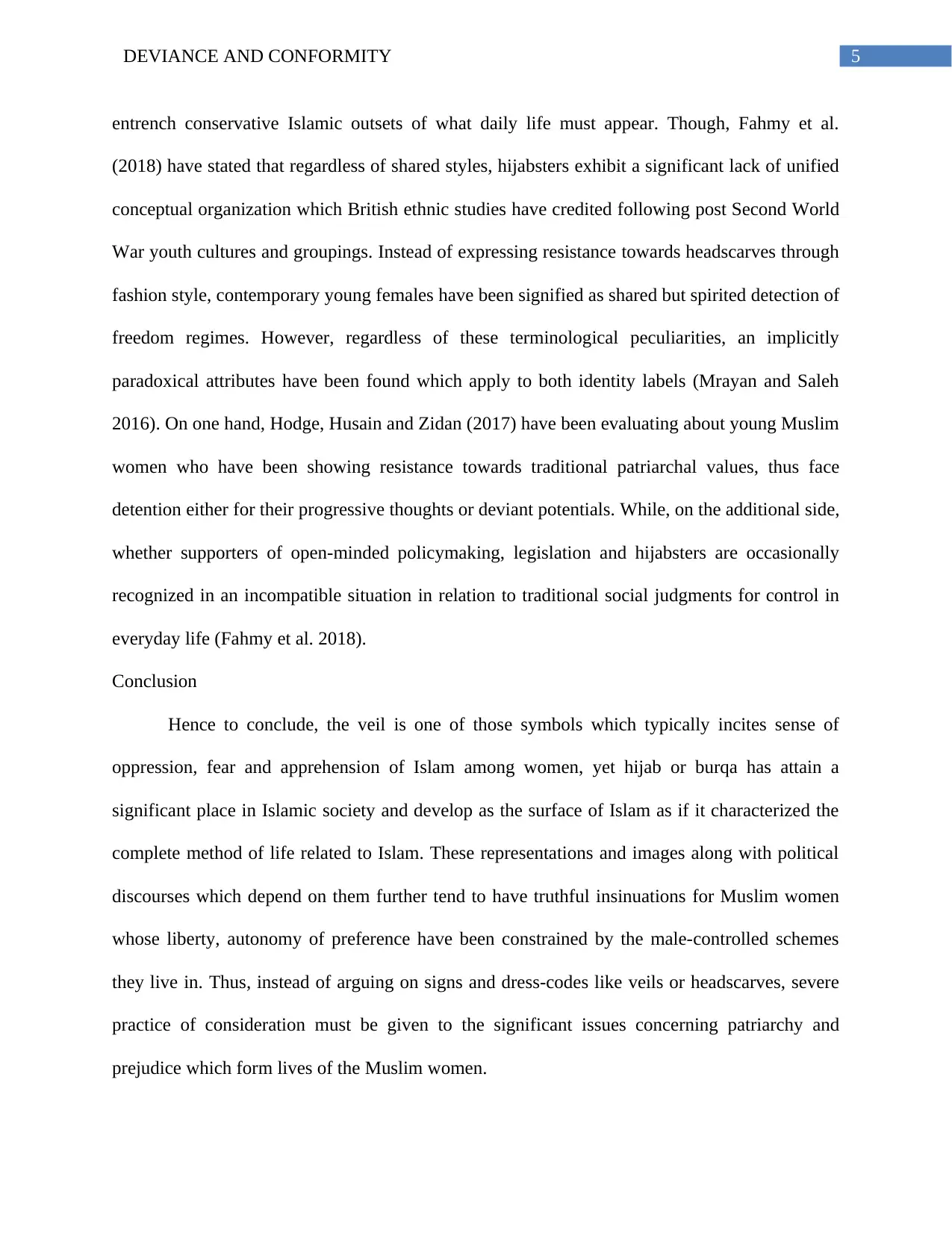
5DEVIANCE AND CONFORMITY
entrench conservative Islamic outsets of what daily life must appear. Though, Fahmy et al.
(2018) have stated that regardless of shared styles, hijabsters exhibit a significant lack of unified
conceptual organization which British ethnic studies have credited following post Second World
War youth cultures and groupings. Instead of expressing resistance towards headscarves through
fashion style, contemporary young females have been signified as shared but spirited detection of
freedom regimes. However, regardless of these terminological peculiarities, an implicitly
paradoxical attributes have been found which apply to both identity labels (Mrayan and Saleh
2016). On one hand, Hodge, Husain and Zidan (2017) have been evaluating about young Muslim
women who have been showing resistance towards traditional patriarchal values, thus face
detention either for their progressive thoughts or deviant potentials. While, on the additional side,
whether supporters of open-minded policymaking, legislation and hijabsters are occasionally
recognized in an incompatible situation in relation to traditional social judgments for control in
everyday life (Fahmy et al. 2018).
Conclusion
Hence to conclude, the veil is one of those symbols which typically incites sense of
oppression, fear and apprehension of Islam among women, yet hijab or burqa has attain a
significant place in Islamic society and develop as the surface of Islam as if it characterized the
complete method of life related to Islam. These representations and images along with political
discourses which depend on them further tend to have truthful insinuations for Muslim women
whose liberty, autonomy of preference have been constrained by the male-controlled schemes
they live in. Thus, instead of arguing on signs and dress-codes like veils or headscarves, severe
practice of consideration must be given to the significant issues concerning patriarchy and
prejudice which form lives of the Muslim women.
entrench conservative Islamic outsets of what daily life must appear. Though, Fahmy et al.
(2018) have stated that regardless of shared styles, hijabsters exhibit a significant lack of unified
conceptual organization which British ethnic studies have credited following post Second World
War youth cultures and groupings. Instead of expressing resistance towards headscarves through
fashion style, contemporary young females have been signified as shared but spirited detection of
freedom regimes. However, regardless of these terminological peculiarities, an implicitly
paradoxical attributes have been found which apply to both identity labels (Mrayan and Saleh
2016). On one hand, Hodge, Husain and Zidan (2017) have been evaluating about young Muslim
women who have been showing resistance towards traditional patriarchal values, thus face
detention either for their progressive thoughts or deviant potentials. While, on the additional side,
whether supporters of open-minded policymaking, legislation and hijabsters are occasionally
recognized in an incompatible situation in relation to traditional social judgments for control in
everyday life (Fahmy et al. 2018).
Conclusion
Hence to conclude, the veil is one of those symbols which typically incites sense of
oppression, fear and apprehension of Islam among women, yet hijab or burqa has attain a
significant place in Islamic society and develop as the surface of Islam as if it characterized the
complete method of life related to Islam. These representations and images along with political
discourses which depend on them further tend to have truthful insinuations for Muslim women
whose liberty, autonomy of preference have been constrained by the male-controlled schemes
they live in. Thus, instead of arguing on signs and dress-codes like veils or headscarves, severe
practice of consideration must be given to the significant issues concerning patriarchy and
prejudice which form lives of the Muslim women.
⊘ This is a preview!⊘
Do you want full access?
Subscribe today to unlock all pages.

Trusted by 1+ million students worldwide
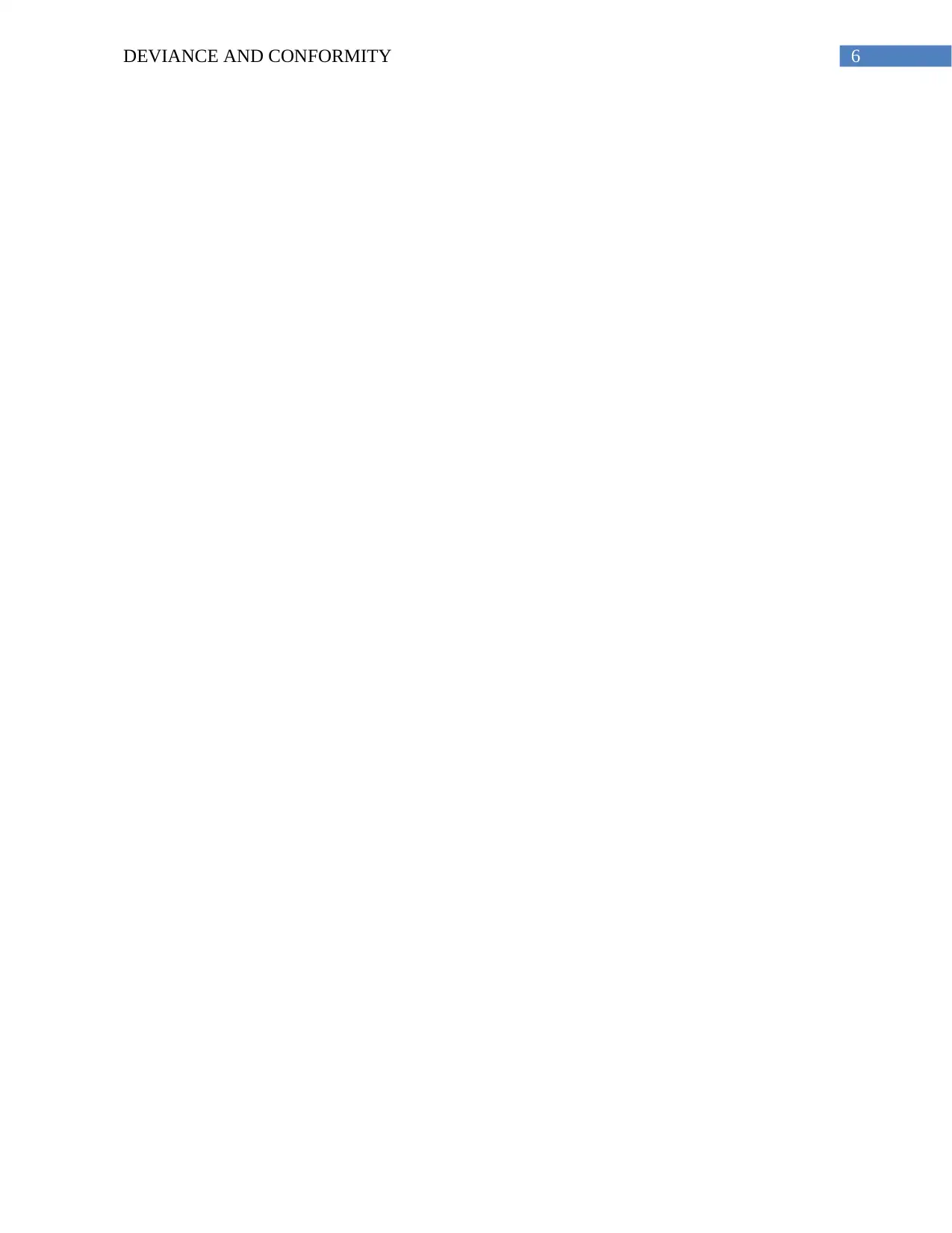
6DEVIANCE AND CONFORMITY
Paraphrase This Document
Need a fresh take? Get an instant paraphrase of this document with our AI Paraphraser
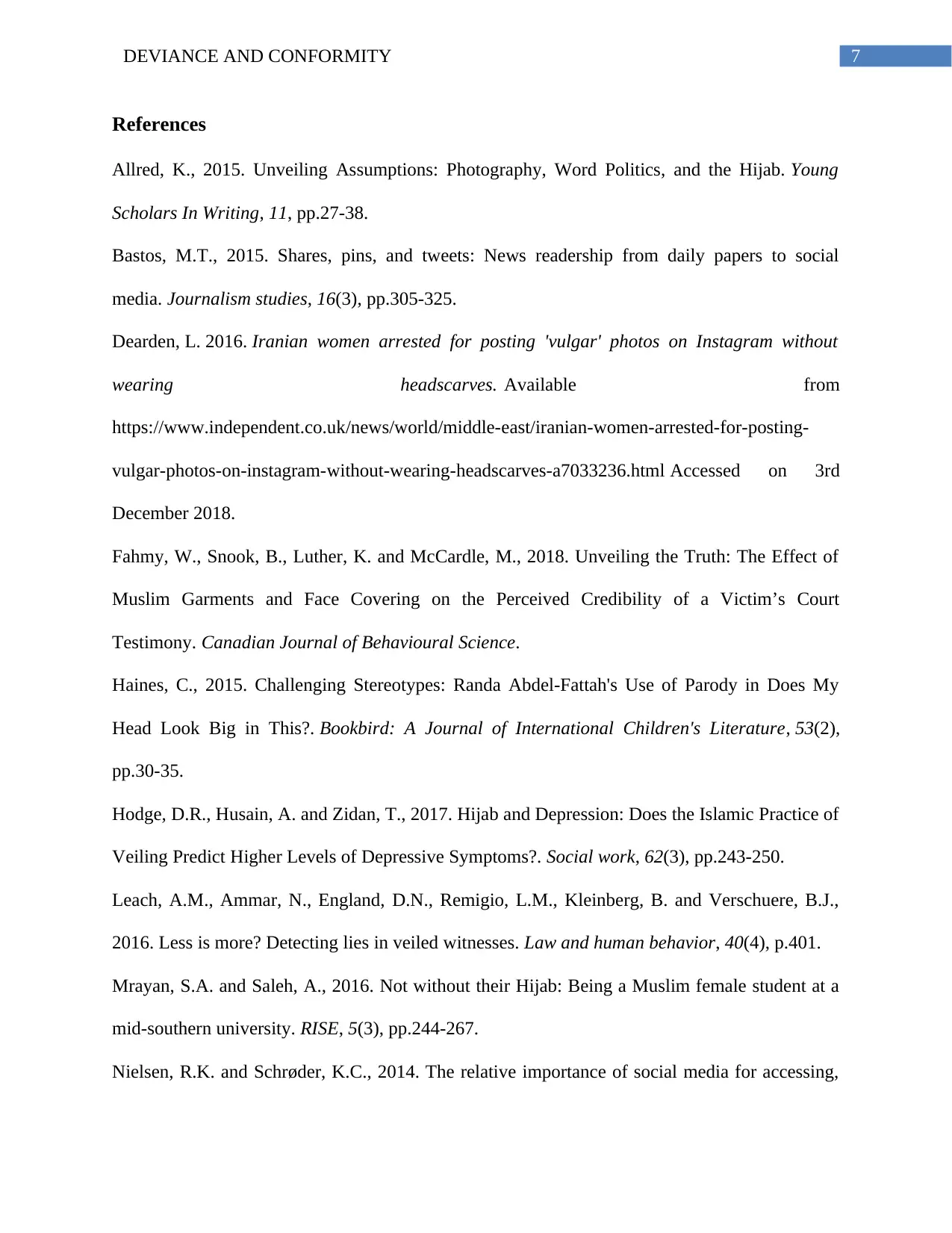
7DEVIANCE AND CONFORMITY
References
Allred, K., 2015. Unveiling Assumptions: Photography, Word Politics, and the Hijab. Young
Scholars In Writing, 11, pp.27-38.
Bastos, M.T., 2015. Shares, pins, and tweets: News readership from daily papers to social
media. Journalism studies, 16(3), pp.305-325.
Dearden, L. 2016. Iranian women arrested for posting 'vulgar' photos on Instagram without
wearing headscarves. Available from
https://www.independent.co.uk/news/world/middle-east/iranian-women-arrested-for-posting-
vulgar-photos-on-instagram-without-wearing-headscarves-a7033236.html Accessed on 3rd
December 2018.
Fahmy, W., Snook, B., Luther, K. and McCardle, M., 2018. Unveiling the Truth: The Effect of
Muslim Garments and Face Covering on the Perceived Credibility of a Victim’s Court
Testimony. Canadian Journal of Behavioural Science.
Haines, C., 2015. Challenging Stereotypes: Randa Abdel-Fattah's Use of Parody in Does My
Head Look Big in This?. Bookbird: A Journal of International Children's Literature, 53(2),
pp.30-35.
Hodge, D.R., Husain, A. and Zidan, T., 2017. Hijab and Depression: Does the Islamic Practice of
Veiling Predict Higher Levels of Depressive Symptoms?. Social work, 62(3), pp.243-250.
Leach, A.M., Ammar, N., England, D.N., Remigio, L.M., Kleinberg, B. and Verschuere, B.J.,
2016. Less is more? Detecting lies in veiled witnesses. Law and human behavior, 40(4), p.401.
Mrayan, S.A. and Saleh, A., 2016. Not without their Hijab: Being a Muslim female student at a
mid-southern university. RISE, 5(3), pp.244-267.
Nielsen, R.K. and Schrøder, K.C., 2014. The relative importance of social media for accessing,
References
Allred, K., 2015. Unveiling Assumptions: Photography, Word Politics, and the Hijab. Young
Scholars In Writing, 11, pp.27-38.
Bastos, M.T., 2015. Shares, pins, and tweets: News readership from daily papers to social
media. Journalism studies, 16(3), pp.305-325.
Dearden, L. 2016. Iranian women arrested for posting 'vulgar' photos on Instagram without
wearing headscarves. Available from
https://www.independent.co.uk/news/world/middle-east/iranian-women-arrested-for-posting-
vulgar-photos-on-instagram-without-wearing-headscarves-a7033236.html Accessed on 3rd
December 2018.
Fahmy, W., Snook, B., Luther, K. and McCardle, M., 2018. Unveiling the Truth: The Effect of
Muslim Garments and Face Covering on the Perceived Credibility of a Victim’s Court
Testimony. Canadian Journal of Behavioural Science.
Haines, C., 2015. Challenging Stereotypes: Randa Abdel-Fattah's Use of Parody in Does My
Head Look Big in This?. Bookbird: A Journal of International Children's Literature, 53(2),
pp.30-35.
Hodge, D.R., Husain, A. and Zidan, T., 2017. Hijab and Depression: Does the Islamic Practice of
Veiling Predict Higher Levels of Depressive Symptoms?. Social work, 62(3), pp.243-250.
Leach, A.M., Ammar, N., England, D.N., Remigio, L.M., Kleinberg, B. and Verschuere, B.J.,
2016. Less is more? Detecting lies in veiled witnesses. Law and human behavior, 40(4), p.401.
Mrayan, S.A. and Saleh, A., 2016. Not without their Hijab: Being a Muslim female student at a
mid-southern university. RISE, 5(3), pp.244-267.
Nielsen, R.K. and Schrøder, K.C., 2014. The relative importance of social media for accessing,
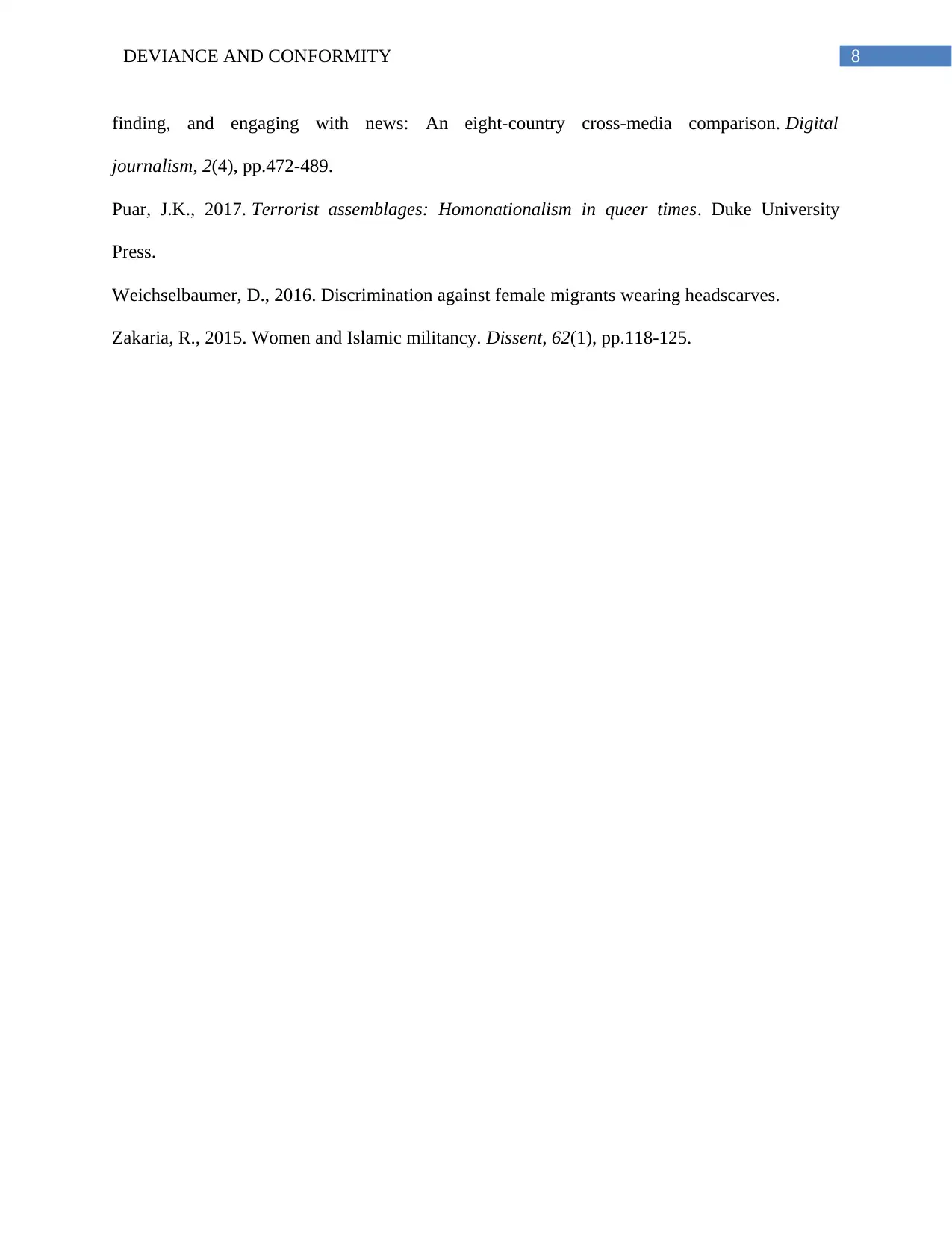
8DEVIANCE AND CONFORMITY
finding, and engaging with news: An eight-country cross-media comparison. Digital
journalism, 2(4), pp.472-489.
Puar, J.K., 2017. Terrorist assemblages: Homonationalism in queer times. Duke University
Press.
Weichselbaumer, D., 2016. Discrimination against female migrants wearing headscarves.
Zakaria, R., 2015. Women and Islamic militancy. Dissent, 62(1), pp.118-125.
finding, and engaging with news: An eight-country cross-media comparison. Digital
journalism, 2(4), pp.472-489.
Puar, J.K., 2017. Terrorist assemblages: Homonationalism in queer times. Duke University
Press.
Weichselbaumer, D., 2016. Discrimination against female migrants wearing headscarves.
Zakaria, R., 2015. Women and Islamic militancy. Dissent, 62(1), pp.118-125.
⊘ This is a preview!⊘
Do you want full access?
Subscribe today to unlock all pages.

Trusted by 1+ million students worldwide
1 out of 9
Your All-in-One AI-Powered Toolkit for Academic Success.
+13062052269
info@desklib.com
Available 24*7 on WhatsApp / Email
![[object Object]](/_next/static/media/star-bottom.7253800d.svg)
Unlock your academic potential
Copyright © 2020–2025 A2Z Services. All Rights Reserved. Developed and managed by ZUCOL.